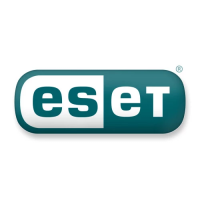42
This chapter is devoted to describe tips and tricks concerned with conguration of NOD32LMS/NOD32BMS. This
means it describes conguration of NOD32LMS/NOD32BMS in circumstances when for instance MTA is congured to
use other software with similar functionality or with functionality that could normally lead to misconguration of
NOD32LMS/NOD32BMS.
7.1. Dropping messages marked by NOD32 as deleted in MTA Postx
In the Internet there has recently appeared non-negligible increase of the number of the e-mail messages
containing so-called worm programs. In most cases the infected attachment of such messages cannot be cleaned but
rather deleted and whole messages even does not contain any reasonable information. In this case it has a sense to
discard (or treat in special way) this kind of messages. Mechanism described in this section can be used to suppress
messages marked as deleted in MTA Postx.
First of all one has to add the following entry:
write_to_header=1
into section [smtp] of the main NOD32 conguration le. This setting will result in a modication of each non-clean
e-mail message by means the string ’X-NOD32Result: status’ is inserted into header of themessage. Word ’status’ of the
string is replaced by actual status of the scanning process.
In order to discard all messages that has been marked as ’deleted’, add the following line:
header_checks=regexp:/etc/postx/header_checks
into the ’/etc/postx/main.cf’ conguration le. At the same time you will have to create le ’/etc/postx/header_
checks’ with the following content:
/^X-NOD32Result:deleted/DISCARD
To reread the newly created NOD32 conguration, enter the following command:
/etc/init.d/nod32d reload
To accomplish the whole procedure, one has to restart the MTA Postx.
Note that in older Postx versions DISCARD functionality may not work. In this case warning message ’Postx does
not know the command DISCARD’ appears in the MTA Postx logging output. This can be only solved by update of the
Postx software.
7.2. NOD32LMS/NOD32BMS and TLS support in MTA
Transport Layer Security (TLS) is a protocol guaranting
data privacy in client/server communication over the
Internet. The basic principle of TLS is based on the
SSL encryption of data traveling between client and
server (We have on our mind the SMTP communication
between MTA client and server). This has of course non-
negligible consequences for scanning of this kind of
communication. For instance, once TLS support in MTA is
enabled, the ’wrapping’ methods are impossible as the
whole intercepted SMTP communication is encrypted at
this stage. On the other hand, there is possibility to use
POSTFIX
NOD32
Content lter
2525
INTERNET
25
25
2526
MAILBOX
SMPT/TLS
Figure 7-1. Scheme of content ltering in Postx MTA with
enabled TLS.
NOD32 for Linux/BSD Mail Server

